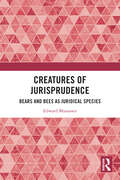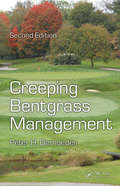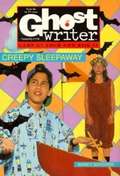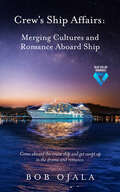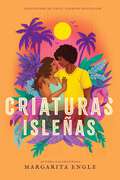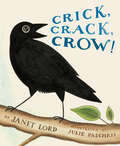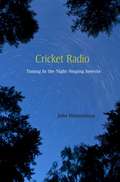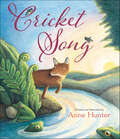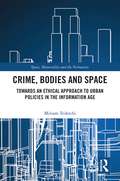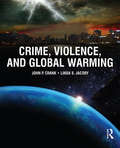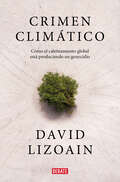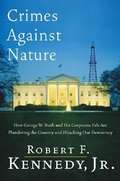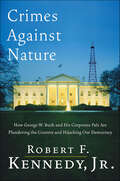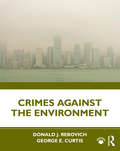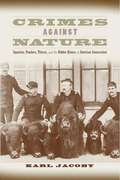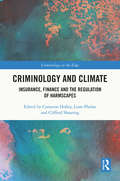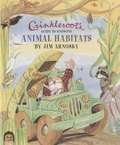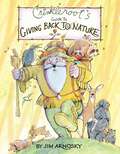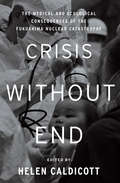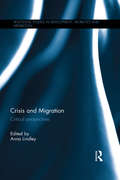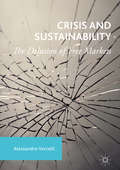- Table View
- List View
Creatures of Jurisprudence: Bears and Bees as Juridical Species
by Edward MussawirTo what extent can an animal constitute a ‘juridical species’? This highly original book considers how animals have been integral to law and to legal thinking.Going beyond the traditional approaches to animal rights and the question of whether non-human animals may be considered legal ‘subjects,’ this book follows two types of animal – bears and bees – and asks what existence these species have maintained in juridical thought. Uncovering surprising roles that the animals play in the imagination of and solution to jurisprudential problems, the book offers a counter-argument to the view that juridical thought reduces one’s appreciation for the singularity and independence of their lives. It shows, rather, that the animals exert a remarkable influence on the creative dimensions of law, offering a liveliness to it that is worthy of close attention.Contributing to new directions at the intersection of jurisprudence and human–animal studies, this book will appeal to those with interests in either of these areas.
Creeping Bentgrass Management
by Peter H. DernoedenCreeping bentgrass is considered the premier turfgrass species grown on golf courses, and there is a growing demand for an understanding of its maintenance and management practices. Still the only comprehensive reference on the subject, Creeping Bentgrass Management, Second Edition helps you identify the factors that contribute to summer bentgrass
Creepy Sleepaway
by Nancy ButcherWhen Hector disappears shortly after his arrival in the Catskill Mountains, his camp counselor believes that everyone is just playing a joke, and the gang enlists the help of the Ghostwriter to stop a kidnapper.
Crew's Ship Affairs: Merging Cultures and Romance Aboard Ship
by Bob OjalaCrew’s Ship Affairs is the third book in the stand-alone Blue-Collar Romance novels series, written by Bob Ojala. The previous two books, A Tugboater’s Life and The Tugboater Family revolved around the drama and romances of the Great Lakes sailors working in the tough and dangerous Marine Construction business.. This third novel continues with many of the same endearing characters, with a new character, Bob Evers, continuing to tell the tugboater crews about his unusual experiences while working aboard numerous passenger cruise ships. Most cruise ship passengers are not privy to what happens beneath the passenger decks, but Bob Evers experienced and understands the relationships that can occur, both good and bad, when 600-1000 men and women live together for four to eight months at a time.. The Crew’s Ship Affairs reader will be shocked and fascinated, even at times envious, of how these various cultures learn to treat one another with respect. Romance takes on many different meanings under such circumstances.. Mr. Ojala is a Naval Architect and Marine Surveyor, very familiar with the Great Lakes. He has traveled the world to inspect ships, including over 165 Passenger Ship Cruises as an environmental auditor.. Most of the characters and experiences in the Blue-Collar Romances series come from Mr. Ojala’s personal observations, changing the names where needed. His respect for the sailors and their families is obvious in these stories.. Maritime industry readers will love the true-life drama, and readers appreciating good romance will love the character’s personal interactions.
Criaturas isleñas (Island Creatures)
by Margarita EngleDe la galardonada autora Margarita Engle llega una inspiradora y luminosa historia de amor contada en verso sobre amigos de la infancia, una vez perdidos y ahora reconectados, y su lucha por proteger a los animales en peligro de extinción.Cada día, Vida lee a las criaturas en el centro de rescate de vida silvestre y sueña con su infancia en Cuba, donde ella y su mejor amigo Adán aventuraban por la isla rescatando animales del peligro. Sin que ella lo sepa, Adán también se ha mudado a Florida y se siente atrapado en su nuevo hogar, sacudido por las tormentosas peleas entre su abuelo y su papi. Cuando un encuentro casual con un zorro cautivo los lleva a reunirse, Vida y Adán pueden encontrar refugio de la crueldad que los rodea en su resplandeciente y reavivado romance. Su amor alcanza nuevas alturas mientras trabajan juntos en el zoológico que rescata especies raras, pero pronto se dan cuenta de que esta paz es solo temporal. Al igual que la vida silvestre que quieren proteger, Vida y Adán están atrapados en un ciclo de desconfianza y crueldad. A medida que viejos rencores familiares y dolorosos recuerdos salen a la luz, ¿podrán ellos y sus familias aprender a sanar y perdonarse para un futuro más brillante y amable?
Crick, Crack, Crow!
by Janet LordCrow&’s mischievous antics are featured in this playful and informative picture book that illustrates the cleverness of crows and their intriguing behavior.Crows are crafty birds. In this picture book about a particularly noisy and mischievous young crow, their intriguing behaviors are on full display. They can mimic sounds and use objects for tools, and they love to hide things. They also enjoy raising a ruckus. Follow along as Crow leaves his home nest and his large extended family and flies to the nearby farm, looking for fun and trouble. He enjoys pestering the songbirds, stealing food from Cat, and taunting Dog. But he soon tires of his usual hijinks, and he sets out to find more exciting adventures. What will happen when he runs into DANGEROUS trouble?This engaging work of informational fiction is a dynamic read-aloud with colorful artwork by the celebrated illustrator Julie Paschkis. The book includes a page of facts about crows and a list of resources for learning more about these fascinating birds.
Cricket Radio: Tuning in the Night-Singing Insects
by John HimmelmanAt a time when night-singing insects have slipped beyond our notice—indeed, are more likely to be heard as NatureSounds than in a backyard—John Himmelman seeks to reconnect us to creatures whose songs form a part of our own natural history. On warm summer evenings, night-singing insects produce a whirring, chirping soundscape—a calming aural tapestry celebrated by poets and naturalists for millennia. But “cricket radio” is not broadcast for the easy-listening pleasure of humans. The nocturnal songs of insects are lures and warnings, full of risks and rewards for these tiny competitive performers. What moves crickets and katydids to sing, how they produce their distinctive sounds, how they hear the songs of others, and how they vary cadence, volume, and pitch to attract potential mates, warn off competitors, and evade predators is part of the engaging story Cricket Radio tells. Himmelman’s narrative weaves together his personal experiences as an amateur naturalist in search of crickets and katydids with the stories of scientists who study these insects professionally. He also offers instructions for bringing a few of the little singers into our homes and gardens. We can, Himmelman suggests, be reawakened to these night songs that have meant so much to the human psyche. The online insect calls that accompany this colorfully illustrated narrative provide a bridge of sound to our past and to our vital connection with other species.
Cricket Song
by Anne HunterA poignant and beautiful bedtime book, Cricket Song connects two children on different continents through the evocation of sound and smell. Readers will love identifying various creatures portrayed in the book and watching what they are doing as the two children begin to fall to sleep in their beds on seemingly opposite sides of the world. While differences between cultures may be obvious, ultimately, this lovely story of sleep is a tale about interconnection.
Cricket in the Classroom
by Della Ross FerreriNick and Emily chase a cricket around their classroom.
Cries from the Ark
by Dan MacIsaacA pitch-perfect debut and a call to act in the service of Earth through radiant attention. Humankind, at present, has breached floodgates that have only been breached before in ancient stories of angry gods, or so far back on geologic and biological timelines as to seem more past than past. Against this catastrophic backdrop (at the end of consolations, at the high-water mark), and equipped with a periscopic eye and a sublime metaphorical reach, poet Dan MacIsaac has crowded his debut vessel with sloths and auks, mummified remains and bumbling explorers, German expressionists and Neolithic cave-painters. With the predominant “I” of so many poetic debuts almost entirely absent, Cries from the Ark is catalogue and cartography of our common mortal—and moral—lot.
Crime, Bodies and Space: Towards an Ethical Approach to Urban Policies in the Information Age
by Miriam TedeschiWith cities increasingly following rigid rules for designing out crime and producing spaces under surveillance, this book asks how information shapes bodies, space, and, ultimately, policymaking. In recent years, public spaces have changed in Western countries, with the urban realm becoming an ever-more monitored, privatised, homogeneous, and aseptic space that has lost its character, uniqueness, and diversity in the name of ‘security’. This underpins precise moral and political choices in terms of what a space should be, how it can be used, and by whom. These choices generate material consequences concerning urban inequality and freedom, or otherwise, of movement. Based on ethnographic and autoethnographic explorations in London’s ‘criminal’ spaces, this book illustrates how rules, policies, and moral values, far from being abstract concepts, are in fact material. Outlining the basis of a new urban information ethics, the book both exposes and challenges how moral values and predefined categories are applied to, and materially shape, the movement of bodies in urban space with regard to crime and security policies. Drawing on Gilbert Simondon’s information theory and a wide range of work in urban studies, geography, and planning, as well as in surveillance studies, object-oriented ontology, and contemporary theoretical work on both materiality and affect, the book provides a radically new perspective on urban space in general, and crime and security in particular. This book uses a balanced mix of theoretical concepts and empirical study to bring theory and practice together in an intertwining of ethnography and autoethnography.This book will be of interest to students and scholars in the fields of urban studies, urban geography, sociology, surveillance studies, legal theory, socio-legal studies, planning law, environmental law, and land law.
Crime, Violence, and Global Warming
by John P. Crank Linda S. JacobyCrime, Violence, and Global Warming introduces the many connections between climate change and criminal activity. Conflict over natural resources can escalate to state and non-state actors, resulting in wars, asymmetrical warfare, and terrorism. Crank and Jacoby apply criminological theory to each aspect of this complicated web, helping readers to evaluate conflicting claims about global warming and to analyze evidence of the current and potential impact of climate change on conflict and crime. Beginning with an overview of the science of global warming, the authors move on to the links between climate change, scarce resources, and crime. Their approach takes in the full scope of causes and consequences, present and future, in the United States and throughout the world. The book concludes by looking ahead at the problem of forecasting future security implications if global warming continues or accelerates. This fresh approach to the criminology of climate change challenges readers to examine all sides of this controversial question and to formulate their own analysis of our planet's future.
Crimen climático: Cómo el calentamiento global está provocando un genocidio
by David LizoainEl título de este libro no debería sorprendernos. Hoy toda política es política climática, y está en juego quién vive y quién muere. Estamos viviendo un momento decisivo para el planeta, que se encuentra al borde del colapso por culpa de las acciones humanas. En este fascinante ensayo de naturaleza optimista, aunque en ocasiones pueda parecer lo contrario, David Lizoain señala a los principales responsables de la actual emergencia climática y expone los puntos clave para un Green New Deal, ese indispensable proyecto de reestructuración económica masiva con el que lograríamos evitar el colapso y que culminaría en un nuevo régimen social y energético: el socialismo solar. Se espera que a lo largo de esta década vayan sucediéndose incontables desastres (pandemias, olas de calor, la pérdida de hábitats hasta ahora intactos, un descenso significativo de la biodiversidad...), algunos de los cuales ya han comenzado a desplegar sus terribles efectos. Estos no hacen sino confirmar la más que urgente necesidad de una transformación sin precedentes. ¿Podemos afirmar que lo que está ocurriendo es un genocidio climático? Es la pregunta que plantea Lizoain al inicio del libro. Su respuesta, clara y contundente, es que nadie más que el hombre, con su obsesión por el crecimiento perpetuo, ha abonado el terreno para la catástrofe. El nuestro es ya un mundo de eco-apartheid, y el genocidio climático tiene lugar gracias a la complicidad generalizada de los poderosos. Es hora de terminar con la impunidad, movilizarse y lograr una ruptura radical (y sostenible) con el statu quo.
Crimes Against Nature: How George W. Bush and His Corporate Pals Are Plundering the Country and Hijacking Our Democracy
by Robert F. KennedyIn this powerful and far-reaching indictment of George W. Bush's White House, Robert F. Kennedy, Jr., the country's most prominent environmental attorney, charges that this administration has taken corporate cronyism to such unprecedented heights that it now threatens our health, our national security, and democracy as we know it.
Crimes Against Nature: How George W. Bush and His Corporate Pals Are Plundering the Country and Hijacking Our Democracy
by Robert F. Kennedy Jr.Crimes against Nature reveals the hidden history behind three of the nation's first parklands: the Adirondacks, Yellowstone, and the Grand Canyon. Focusing on conservation's impact on local inhabitants, Karl Jacoby traces the effect of criminalizing such traditional practices as hunting, fishing, foraging, and timber cutting in the newly created parks. Jacoby reassesses the nature of these "crimes" and provides a rich portrait of rural people and their relationship with the natural world in the late nineteenth and early twentieth centuries.
Crimes Against the Environment
by Donald J. Rebovich George E. CurtisCrimes Against the Environment explains the seriousness of the threat posed by pollution, its roots, how it has evolved, how it differs across the planet, and how society has endeavored to create and enforce laws directed at its control. Rebovich and Curtis begin with an overview of hazardous waste, the industries that produce toxins, available methods of waste treatment, and the legal environment of environmental crime. They examine the forces driving criminal behavior and the methods offenders adopt, as well as protections against polluters and their effectiveness. The book concludes with an examination of environmental justice in the United States and globally, and looks ahead to the future of crime control and prevention in this arena. Case studies and discussion questions offer further perspective on these challenging issues of environmental integrity. This text serves undergraduate or early-stage graduate students majoring in criminal justice, environmental science, sociology, and political science, and could also serve as a resource for professionals in environment-related occupations.
Crimes against Nature: Squatters, Poachers, Thieves and the Hidden History of American Conservation
by Karl JacobyCrimes against Nature reveals the hidden history behind three of the nation's first parklands: the Adirondacks, Yellowstone, and the Grand Canyon. Focusing on conservation's impact on local inhabitants, Karl Jacoby traces the effect of criminalizing such traditional practices as hunting, fishing, foraging, and timber cutting in the newly created parks. Jacoby reassesses the nature of these "crimes" and provides a rich portrait of rural people and their relationship with the natural world in the late nineteenth and early twentieth centuries.
Criminology and Climate: Insurance, Finance and the Regulation of Harmscapes (Criminology at the Edge)
by Clifford Shearing Cameron Holley Liam PhelanThis book explores the role of the insurance industry in contributing to, and responding to, the harms that climate change has brought and will bring either directly or indirectly. The Anthropocene signifies a new role for humankind: we are the only species that has become a driving force in the planetary system. What might criminology be in the Anthropocene? What does the Anthropocene suggest for future theory and practice of criminology? Criminology and Climate, as part of Routledge’s Criminology at the Edge Series, seeks to contribute to this research agenda by exploring differing vantage points relevant to thinking within criminology. Contemporary societies are presented with myriad intersecting and interacting climate-related harms at multiple scales. Criminology and Climate brings attention to the finance sector, with a particular focus on the insurance industry as one of its most significant components, in both generating and responding to new climate ‘harmscapes’. Bringing together thought leaders from a variety of disciplines, this book considers what finance and insurance have done and might still do, as ‘fulcrum institutions’, to contribute to the realisation of safe and just planetary spaces. An accessible and compelling read, this book will appeal to students and scholars of criminology, sociology, law and environmental studies and provides readers with a basis to analyse the challenges and opportunities for the finance sector, and in particular the insurance industry, in the regulation of climate harms.
Crinkleroot's Guide To Knowing Animal Habitats
by Jim ArnoskyJoin the folksy, friendly Crinkleroot for a fun, informative walk in the woods. Crinkleroot is the ideal guide to introduce the trees because he was born in one. He knows how to identify individual trees and how they're important to animals in the forest. In these pages, he shares secrets of the forest with readers so that they, too, may get to know different trees like old friends.
Crinkleroot's Guide to Giving Back to Nature
by Jim ArnoskyJim Arnosky's beloved nature expert, Crinkleroot, is back! Award-winning children's book artist and naturalist Jim Arnosky features his iconic character in this fun and informative picture book. Crinkleroot, who was "born in a tree and raised by bees," guides young readers through the natural world, taking them on a journey through the seasons, and giving examples of things they can do in their own backyards to protect the environment.
Crisis Gardening: A Global Perspective (Advances in Agroecology)
by Monika EgererGardening during times of crisis can have significant benefits to individuals and populations interms of health, well-being, social and economic outcomes. So-called ‘crisis gardening’ can even belinked to transformative change in food systems through socio-ecological aspects of agroecology.In this book, crisis gardening is explored to better define, describe and provide recommendationsabout this activity globally. Diverse perspectives are offered from scholars around the world, providingan overview of gardening during crises with ties to agroecology. Such a perspective is criticalas we grapple with food system crises, pandemics, climate change, biodiversity loss, mental healthissues and political conflict globally.• The first section defines and explains crisis gardening in relation to agroecology, transformative change in food systems and public health.• The second section describes case studies from around the world of crisis gardening from various social-ecological perspectives.• The third section provides policy and practice recommendations and how to scale up the lessons from crisis gardening to transform food systems, public health systems, and policy and landscape planning processes.Bringing together leaders and experts (academics, policy makers and practitioners) from around theworld, the book provides case studies of crisis gardening and develops recommendations to harnessthe lessons from this practice.
Crisis Without End: The Medical and Ecological Consequences of the Fukushima Nuclear Catastrophe
by Helen CaldicottExpert essays provide the first comprehensive analysis of the long-term health and environmental consequences of the Fukushima nuclear accident. On the second anniversary of the Fukushima disaster, an international panel of leading medical and biological scientists, nuclear engineers, and policy experts were brought together at the prestigious New York Academy of Medicine by Helen Caldicott, the world&’s leading spokesperson for the antinuclear movement. This was the first comprehensive attempt to address the health and environmental damage done by one of the worst nuclear accidents of our times. A compilation of these important presentations, Crisis Without End represents an unprecedented look into the profound aftereffects of Fukushima. In accessible terms, leading experts from Japan, the United States, Russia, and other nations weigh in on the current state of knowledge of radiation-related health risks in Japan, impacts on the world&’s oceans, the question of low-dosage radiation risks, crucial comparisons with Chernobyl, health and environmental impacts on the United States (including on food and newborns), and the unavoidable implications for the US nuclear energy industry. Crisis Without End is both essential reading and a major corrective to the public record on Fukushima.
Crisis and Migration: Critical Perspectives (Routledge Studies in Development, Mobilities and Migration)
by Anna LindleyCrisis and migration have a long association, in popular and policy discourse as well as in social scientific analysis. Despite the emergence of more nuanced and even celebratory accounts of mobility in recent years, there remains a persistent emphasis on migration being either a symptom or a cause of crisis. Moreover, in the context of a recent series of headline-hitting and politically controversial situations, terms like ‘migration crisis’ and ‘crisis migration’ are acquiring increasing currency among policy-makers and academics. Crisis and Migration provides fresh perspectives on this routine association, critically examining a series of politically controversial situations around the world. Drawing on first-hand research into the Arab uprisings, conflict and famine in the Horn of Africa, cartel violence in Latin America, the global economic crisis, and immigration ‘crises’ from East Asia to Southern Africa to Europe, the book’s contributors situate a set of contemporary crises within longer histories of social change and human mobility, showing the importance of treating crisis and migration as contextualised processes, rather than isolated events. By exploring how migration and crisis articulate as lived experiences and political constructs, the book brings migration from the margins to the centre of discussions of social transformation and crisis; illuminates the acute politicisation and diverse spatialisations of crisis–migration relationships; and urges a nuanced, cautious and critical approach to associations of crisis and migration.
Crisis and Sustainability: The Delusion of Free Markets
by Alessandro VercelliThis book offers a novel interpretation of the Great Recession and the ensuing Euro Crisis as a consequence of the evolution of capitalism since the 1970s. Chapters argue that the neoliberal development trajectory pursued in recent decades is unsustainable, and posit that neither sound macroeconomics nor empirical data support the unqualified faith in free markets that inspired it. The book begins by providing a broad critical perspective on key concepts such as freedom, free market, free trade, globalisation and financialisation, before going on to analyse the long and deep recent crisis as a result of the neoliberal policy strategy adopted since the early 1980s. The alternative narrative outlined in the book provides insights into the policy strategy required to achieve a sustainable development trajectory.
Crisis at McKinnon's Knob (Fountas & Pinnell Classroom, Guided Reading)
by Jennifer Gillis Alexander WellsNIMAC-sourced textbook. A BAD SITUATION. When two brothers find themselves in a dangerous situation while hiking, they call on survival skills they'd learned and hope those skills will be enough to save them.
